Simulator of the nervous system. Part 2. Modulated Neuroelement
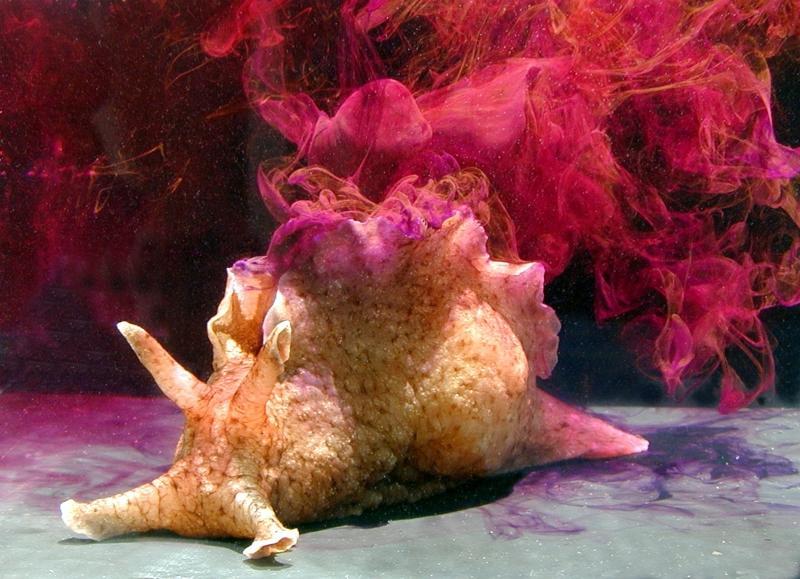
On the title image, a clam of the genus Aplysia, in its nervous system only 20,000 nerve cells. Almost the same as in your nervous system, the same dendrites, axons, mediators. The same proteins and substances. And the path to understanding the nature of consciousness and complex intellectual behavior cannot pass by this humble being.
Hello, Geektimes, and we turn to the second part, which will be devoted to the second type of neuroelements - this is a modulated neuroelement.
Table of contents
1. Simulator of the nervous system. Part 1. Simple adder
2. Simulator of the nervous system. Part 2. Modulated Neuroelement
3. Simulator of the nervous system. Part 3. Associative Neuroelement
4. Memory, memory consolidation and grandmother's neurons
5. Modeling emotions or electronic sense of novelty
6. Amazing cerebellum
7. Structure and starting brain settings
')
There are three types of reflex activity: habituation, sensitization, and the formation of conditioned reflexes. These types of activities were revealed by Academician Pavlov I.P. and if our model does not emulate this, it means that this is not a model of the nervous system, but a model of something else.

Addictive
Habituation is a phenomenon associated with the fact that after repeated actions of an indifferent stimulus, both the animal and the cell stop responding to it. For example, the background sound to which we can get used and after a while almost ceases to hear it, or if you wear a ring for a long time, you may not feel its pressure on the skin, etc.
Habituation is implemented as follows. When a neuroelement is activated, it enters an active state, in which it stops responding to activating factors, such as a signal, from contact synapses or the total amount of the total sum on the adder is exceeded. After some time, the neuroelement produces a response to all of its transmitting synapses. After the signal is transmitted, the time that is indicated as a time of rest or recovery also passes. Further, the state of activity is replaced by a state of waiting, in which the neurocell can react to activating factors and re-enter the state of activity. For the modulated neuroelement after the activity phase, there is an evaluation time for which it is determined whether the neuroelement will be activated again.
If re-activation occurs during this period, then counting repetitions occurs. That is, each time the activation occurs during the evaluation, the repeat counter is incremented by one, but if no activation occurs during the evaluation, the counter is reset. This is how the activations are counted, if they occur frequently enough.
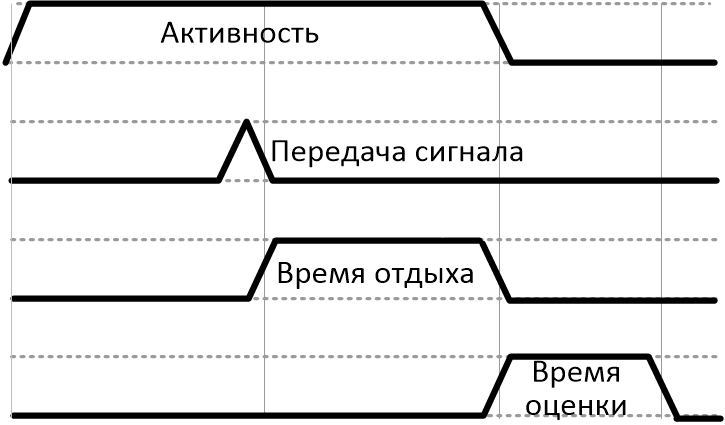
And if the number of repetitions turns out to be above a certain limit, then the neuroelement adder threshold rises by a certain value. Thus, the neuroelement raises its threshold until it stops responding to the level of exposure that activated it.
An example of addiction:
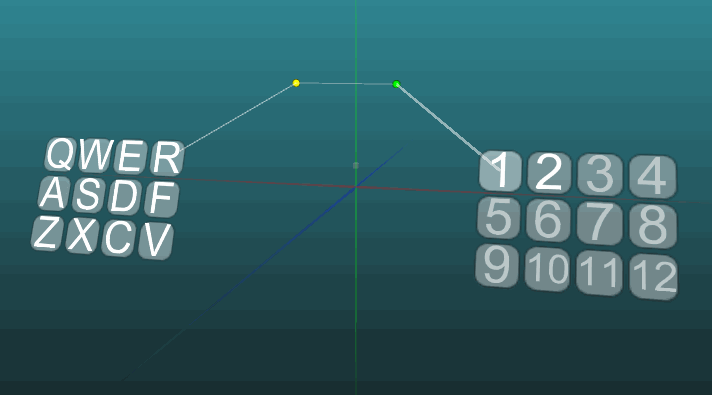
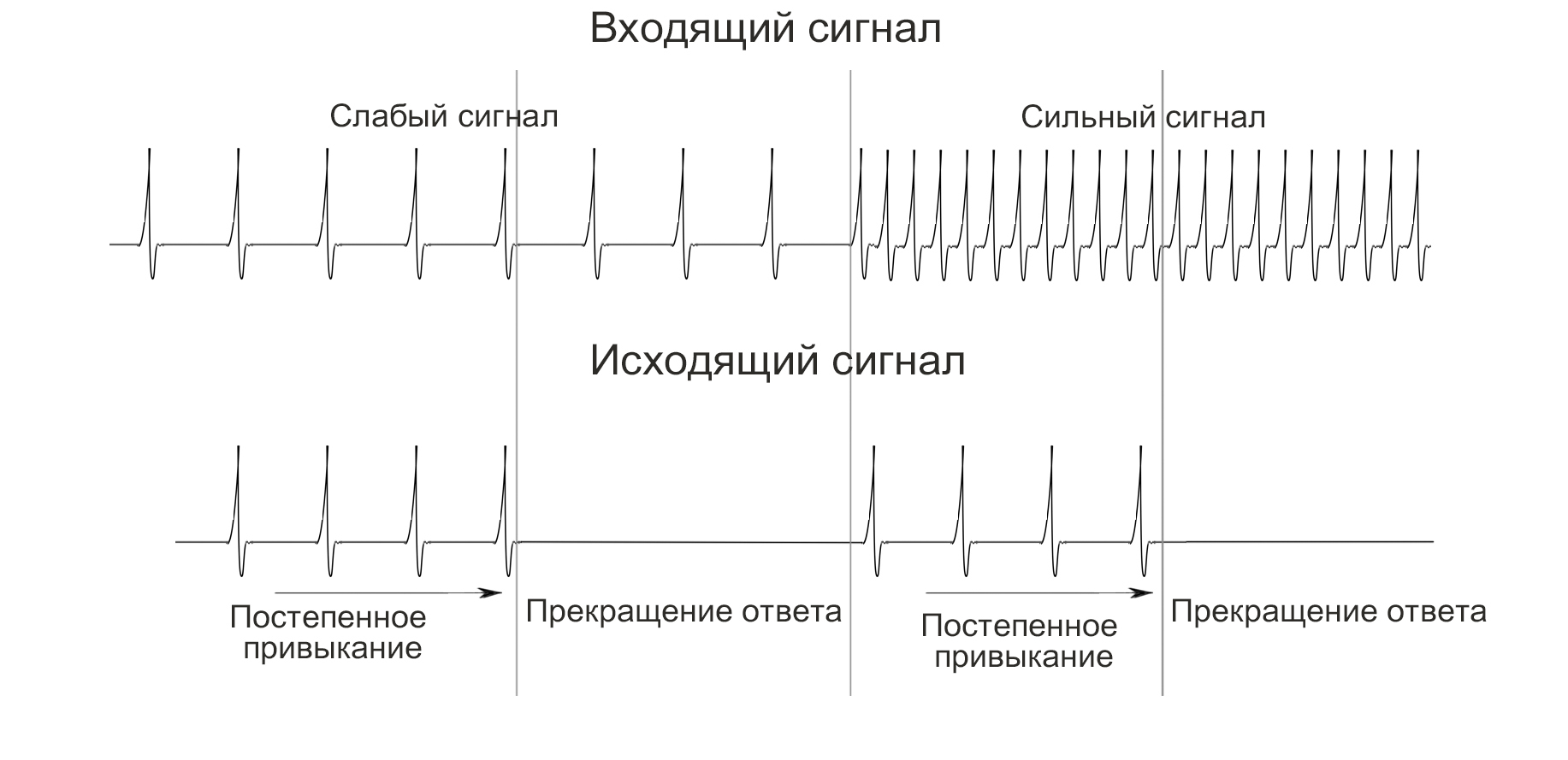
Adaptation
In contrast to addiction, the adaptation mechanism should be distinguished. Adaptation is the ability of the cell over time to return to the previous level of sensitivity. Even after habituation, if there is no habituation stimulus for a long time, the strength of this habituation decreases, and may disappear altogether.
The speed with which recovery takes place can vary in different cases, and sometimes it can last hours or even days, and in some cases it happens very quickly.
Example with adaptation:


The mechanism of habituation can be represented as a defense mechanism, with very frequent activation of the nervous tissue, there is a high probability of its depletion, death and damage. Therefore, in order to protect the sensitivity of the neuron is reduced, and he rarely begins to respond to excitation.
On the other hand, if the neuron is not activated, it will not perform its tasks and, therefore, it would be useless power consumption. Therefore, there is an adaptation mechanism that increases sensitivity to external stimuli, which increases the likelihood of neuron activation.
The properties of the neuroelement addictive and adaptation solve the problem of looping, very often in the nervous tissue the neurons are combined so that they form transmission loops of nervous excitement, such small circular transfers seem to indicate a reflex arc along the propagation path of the excitation. But with annular transmissions of excitement, there is no endless looping; over time, these transmissions also cease due to the rapid adaptation.

Sensitization
The second type of reflex activity is sensitization. Sensitization is an increase in sensitivity to the effects of irritants, even if they are indifferent, if this was preceded by an important event for the body.
For example, for a dog, a certain sound is an indifferent irritant to which it has not previously responded. Then, if an unpleasant irritant is received, for example, an electric shock, then the dog will be alarmed for a while, and even an indifferent sound will cause a characteristic behavior, a defensive reaction.
In order to simulate sensitization, we turn to the works of Eric Kandel, the Nobel Prize winner in the field of physiology. He described in detail the effect of modulating synapses on the example of the nervous system of the Aplysia mollusk.

The mollusk has a defensive reaction in response to all sorts of touches - the gills are drawn in. In his experiments, Eric Kandel, in Aplicia, caused addiction to the light touch of her siphon so that the protective reflex did not work. The protective reflex is preserved for strong effects on the siphon, but with a weak effect it was absent. But if the light touch of the siphon was preceded by the impact on the clam's tail, then the protective reflex worked with the same force and the gills were preserved.

[Illustrations from the book “Looking for Memory” by Eric Kandel]
The nervous system of Aplysia consists of a relatively small number of cells that can be identified and therefore it is possible to make reflex patterns. It is possible to completely isolate the reflex arc responsible for the defensive reaction during the stimulation of the siphon - this is the main circuit. And the chain of neurons responsible for modulation is the modulating circuit that is activated when exposed to the tail of the mollusk.
Eric Kandel described in detail how the modulation takes place in this case, which chemicals are involved in this process, the intracellular cascades of reactions. Let's transfer this knowledge to our model.
And so in our system there is a certain type of synapse - modulating. This type of synapse has no direct activating or inhibiting effect, it affects the level of the activating threshold. The level of activation of the neuroelement consists of two parts, the main and modulated. The main part of the activation threshold is what will change with habituation and adaptation. The modulated part is similar to the adder, it contains all the effects of modulating synapses. The resulting amount is gradually reduced in magnitude and tends to zero. The rate of reduction of the modulating effect is significantly slower than the rate at which the overall impact of direct-acting synapses decreases.
The strength of the modulating synapse may be different in sign, that is, it may raise the threshold, thereby lowering the sensitivity of the neuroelement, or lower the threshold, increasing its sensitivity.
The threshold level at which it is estimated whether the neuroelement will be activated is the sum of the main and modulating parts, this level cannot be zero or below zero.
We simulate the experiments of Eric Kandel with Aplysia.

“Q”, “W”, “E” and “R” receptors are receptors of the mollusk siphon, each of which is associated with a receptor neuroelement. Each receptor neurocell is connected by direct-acting synapses with an inserted modulated neuroelement. Which in turn is associated with the motor neuroelement, which sends a signal to the indicator "1". Indicator "1" will be analogous to the action of the reduction of the gills of Aplysia.
Initially, the network is configured so that the activity of each of the siphon receptors will lead to the action "1". But with prolonged "tickling", unhurried, sequential activation of siphon receptors, after some time the addictive neuroelement becomes addictive and there is no response action. But, if the siphon receptors act more strongly, activate several receptors at once or do it more quickly, then we will see that the “1” reaction will still work. In this case, the adaptation mechanism will be very long in time, and we can neglect it.
Also in our scheme there is a receptor “F”, a clam tail receptor, which is associated with a neuroelement having a synapse of modulating action on the neuroelement. This synapse lowers the level of the neuroelement threshold for a certain time, which makes the neuroelement more sensitive and during this period the activation of even one siphon receptor leads to the reaction "1".
The sensitization mechanism in Aplysia is a prototype of the emotional state of anxiety and fear in animals with a more developed nervous system. In such animals, not separate chains of neurons are involved in sensitization, but entire regions in the nervous system. The area responsible for fear and anxiety is the amygdala, the amygdala, when it is activated, select modulating mediators (adrenaline, norepinephrine). These mediators can have an effect on the motor cortex, increasing the sensitivity of neurons, which increases the activity in the motor vehicle. This means that less intrinsic motivation is required in order to perform certain actions, which makes it possible to quickly run away from danger or to more actively attack and show aggression.
Switch
Modulated neuroelements also make it possible to imagine how the switching behavior of the animal occurs depending on external and internal circumstances. For example, Aplysia demonstrates very complex behavior during the mating period, its behavior during this period changes, and possible reactions to the same stimuli change. That is, one can say about the existence of a certain “switch” in the nervous system of the mollusk.
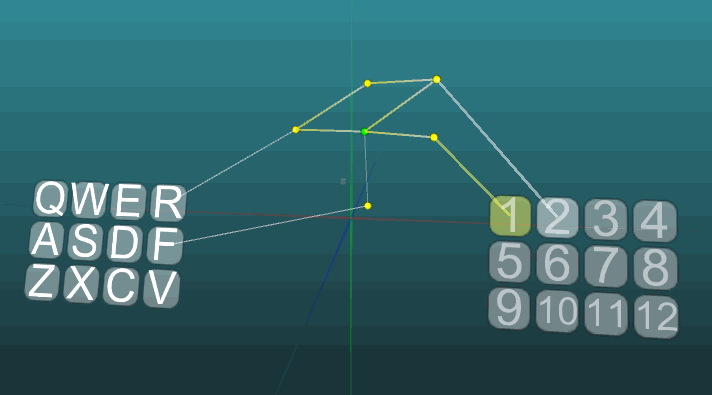
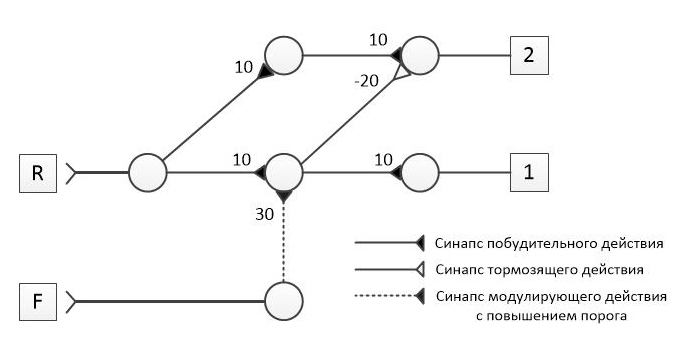
The network is configured so that when the receptor "R" is activated, a reflex response "1" occurs. But if we simulate this network of neuroelements by activating the F receptor, then a reflex response “2” will occur at the same receptor “R”. A modulating factor for the nervous system can be the presence of a certain hormone in the body, which explains how the behavior of the animal changes, for example, during the period of fertility.
Source: https://habr.com/ru/post/397375/
All Articles